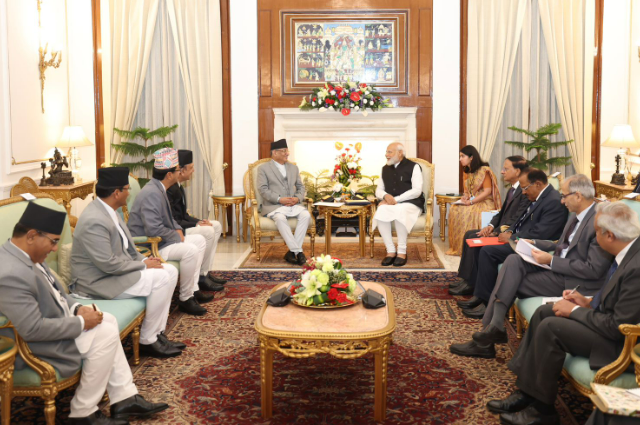Nepal's Prime Minister Pushpa Kamal Dahal, aka 'Prachanda' was on a four-day visit to India from 31st May to 3rd June. It was his first foreign exchange since him taking over as the Prime Minister after the December 2022 Elections.
We can certainly conclude that the visit was a great success as far as the diplomatic game is concerned.
The Indian Prime Minister has interacted with the Nepalese Head to extend the relationship curvatures to a higher dimension.
PM Modi remarks, 'Indo-Nepalese relations should be higher than the Himalayas.' He also adds that his visit to Nepal had been a huge hit and that they should put in effort to make this challenge a success.
Prachanda's visit was significant and was different from the previous ones in 2002, 2004, or that of 1996.
His visit was different as reported in the following strands:
- Given the communist influence, the Prime Minister of Nepal was in his traditional outfit 'daurasuruwal'.
- Preferred Delhi as his first call over Beijing.
- His predecessor, KP Oli had a greater inclination for China.
- Prachanda had earlier criticised for New Delhi's perceived micro-management of Kathmandu.
- Just as any politician would do, he was running on the axiomatic principles of the great German Chancellor, Otto Von Bismarck in the reference of, 'Politics is the art of possible.'
- He is leading a coalition of his own party Maoist Centre which has won very less seats in the Parliament relative to the Nepali Congress with a maximum of 88 seats.
- Initially, he had aligned with Oli's Unified Marxist-Leninist Party but fractured from it due to Oli's dominant demands. Later, he embraced the candidature of Presidentship from the Nepali Congress.
- We should note that the fragile domestic power-politics in Nepal produces a discernible effect. Ever since, it has become a Republic in 2008, successive governments have taken into power.
Effected Success Out of the Agreement:
- The landmark agreement for India to import 10,000 megawatt power from Nepal in the coming 10 years. Hydropower is Nepal's biggest asset. Generation and supply to India can lead to unprecedented results. This will help India to cut down it's fossil fuel usage for energy generation.
- India has agreed to allow Nepal to sell power to Bangladesh using the Indian transmission network. It is expected that the trio will result into 'big agreements' in future.
- Many infrastructural agreements were signed and inaugurated. The agreements and deliberations involve trade activities, construction of motorable bridges, cross-border railways, petroleum pipelines, irrigation and civil aviation etc. The agreements included 'Check-Posts' (ICPs) to facilitate trade transport between the two countries. The Transit Treaty of 1992 is going to be renewed with construction of waterways and rail routes. Cooperation is also going to established in terms of petroleum infrastructure.
- A MoU between the Institute of Foreign Affairs Nepal and Institute of Foreign Services, Delhi has been established.
- Agreements for quicker cross-border payment for business, students and tourists of both the countries.
- Engagement of both public and private sectors is encouraged for both the countries.
Prachanda knows India too well. He had spent time as a Maoist insurgent in India fighting against Nepal monarchy. Nepal is praising the G-20's leadership of India. Diplomatic routes are suggested to solve the contentious issues although territorial structures nosedived relations also.
Larger diplomatic strategy reveals that China is trying to grab influence on Kathmandu as India heads to maintain its traditional friendship and proximity. Furthermore, USA also seems to appear into fray.
Prachanda's visit to Nepal happens in the backdrop of a law that was passed which allows Indian women to be married to Nepali men to allow the former to gain citizenship of the country after a certain period of naturalization.
India needs to focus on its 'Neighbour-First' policy, especially with Nepal with strong cultural ties. Madhesi (people of Indian origin) in Nepal treat India for what they call a 'roti-beti' relation meaning for marriage and a shared culture.
Thus, a new chapter seems to have ushered in with Prachanda's visit to India leading to a pragmatic approach for India-Nepal ties.
. . .
Reference:
- dailyexcelsior.com

